Near-Ground Profile of Bora Wind Speed at Razdrto, Slovenia
Abstract
1. Introduction
2. Methodology
2.1. Instrumentation and Data Collection
- NE wind direction (0–90°, defined by the direction of the orographic barrier).
- Minimum wind speed greater than 7 m/s at the reference height.
- Mean wind speed of the whole episode greater than 10 m/s at the reference height.
- Minimal duration of an episode has to be at least 12 h.
2.2. Data Analysis
2.3. Terrain Characterization along the Upstream Bora Path
3. Results
3.1. Power Law and Logarithmic Law Description of the Bora Wind Speed Profile
3.2. Variability of Model Parameters
3.3. Relationships between Power Law and Logarithmic Law Coefficients
4. Conclusions
Author Contributions
Funding
Acknowledgments
Conflicts of Interest
References
- Jurčec, V. On mesoscale characteristics of Bora conditions in Yugoslavia. In Weather and Weather Maps; Springer: Birkhäuser, Basel, 1981; pp. 640–657. [Google Scholar]
- Petkovšek, Z. Main Bora gusts–a model explanation. Geofizika 1987, 4, 41–50. [Google Scholar]
- Belušić, D.; Hrastinski, M.; Večenaj, Ž.; Grisogono, B. Wind regimes associated with a mountain gap at the northeastern Adriatic coast. J. Appl. Meteorol. Climatol. 2013, 52, 2089–2105. [Google Scholar] [CrossRef]
- Belusić, D.; Bencetić Klaić, Z. Mesoscale dynamics, structure and predictability of a severe Adriatic Bora case. Meteorol. Z. 2006, 15, 157–168. [Google Scholar] [CrossRef]
- Mole, M.; Wang, L.; Stanič, S.; Bergant, K.; Eichinger, W.E.; Ocaña, F.; Strajnar, B.; Škraba, P.; Vučković, M.; Willis, W.B. Lidar measurements of Bora wind effects on aerosol loading. J. Quant. Spectrosc. Radiat. Transf. 2017, 188, 39–45. [Google Scholar] [CrossRef]
- Pristov, N.; Petkovšek, Z.; Zaveršek, J. Some characteristics of Bora and its beginnings in Slovenia. Razprave 1989, 30, 37–52. [Google Scholar]
- Defant, F. Local winds. In Compendium of Meteorology; Springer: Boston, MA, USA, 1951; pp. 655–672. [Google Scholar]
- Henin, R. Dynamics of Bora Wind Over the Adriatic Sea: Atmospheric Water Balance and Role of Air-Sea Fluxes and Orography. Ph.D. Thesis, University of Bologna, Bologna, Italy, 2015. [Google Scholar]
- Grisogono, B.; Belusšić, D. A review of recent advances in understanding the mesoand microscale properties of the severe Bora wind. Tellus Dyn. Meteorol. Oceanogr. 2009, 61, 1–16. [Google Scholar] [CrossRef]
- Jurčec, V. The Adriatic frontal Bora type. Hrvat. Meteoroloski Cas. 1988, 23, 13–25. [Google Scholar]
- Petkovšek, Z. Burja v Sloveniji in nekoliko južneje. In Pol Stoletja Slovenskega Meteorološkega Društva; Bulletin of Slovenian Meteorological Society: Ljubljana, Slovenia, 2004; pp. 251–268. Available online: http://www.meteo-drustvo.si/zgodovina/pol-stoletja-smd/50let-publikacija/ (accessed on 20 May 2019).
- Yoshino, M. Local wind Bora; University of Tokyo Press: Tokyo, Japan, 1976. [Google Scholar]
- Smith, R.B. Aerial observations of the Yugoslavian Bora. J. Atmos. Sci. 1987, 44, 269–297. [Google Scholar] [CrossRef]
- Klemp, J.; Durran, D. Numerical modelling of Bora winds Numerische Modellierung der Bora. Meteorol. Atmos. Phys. 1987, 36, 215–227. [Google Scholar] [CrossRef]
- Smith, R.B. On severe downslope winds. J. Atmos. Sci. 1985, 42, 2597–2603. [Google Scholar] [CrossRef]
- Smith, R.B.; Sun, J. Generalized hydraulic solutions pertaining to severe downslope winds. J. Atmos. Sci. 1987, 44, 2934–2939. [Google Scholar] [CrossRef]
- Belušić, D.; Bencetić Klaić, Z. Estimation of Bora wind gusts using a limited area model. Tellus Dyn. Meteorol. Oceanogr. 2004, 56, 296–307. [Google Scholar] [CrossRef][Green Version]
- Efimov, V.; Barabanov, V. Simulation of Bora in Novorossiysk. Russ. Meteorol. Hydrol. 2013, 38, 171–176. [Google Scholar] [CrossRef]
- Ivančan-Picek, B.; Ivatek-Šahdan, S.; Grubišić, V. Vertical structure of the Dinaric Alps flow during MAP IOP 15. Hrvat. Meteoroloski Cas. 2005, 40, 176–179. [Google Scholar]
- Šoljan, V.; Belušić, A.; Šarović, K.; Nimac, I.; Brzaj, S.; Suhin, J.; Belavić, M.; Večenaj, Ž.; Grisogono, B. Micro-Scale Properties of Different Bora Types. Atmosphere 2018, 9, 116. [Google Scholar] [CrossRef]
- Belušić, D.; Pasarić, M.; Orlić, M. Quasi-periodic Bora gusts related to the structure of the troposphere. QJR Meteorol. Soc. 2004, 130, 1103–1121. [Google Scholar] [CrossRef]
- Lepri, P.; Kozmar, H.; Večenaj, Ž.; Grisogono, B. A summertime near-ground velocity profile of the Bora wind. Wind Struct. 2014, 19, 505–522. [Google Scholar] [CrossRef]
- Lepri, P.; Večenaj, Ž.; Kozmar, H.; Grisogono, B. Near-ground turbulence of the Bora wind in summertime. J. Wind. Eng. Ind. Aerodyn. 2015, 147, 345–357. [Google Scholar] [CrossRef]
- Lepri, P.; Vecenaj, Z.; Kozmar, H.; Grisogono, B. Bora wind characteristics for engineering applications. Wind Struct. 2017, 24, 579–611. [Google Scholar]
- Flay, R.; Stevenson, D. Integral length scales in strong winds below 20 m. J. Wind. Eng. Ind. Aerodyn. 1988, 28, 21–30. [Google Scholar] [CrossRef]
- EN 1991–1–4:2005 (sl) Evrokod 1: Vplivi na Konstrukcije—1-4.del: Splošni Vplivi—Vplivi Vetra. Available online: https://www.gzs.si/zbornica_gradbenistva_in_industrije_gradbenega_materiala/vsebina/Gradbeni-standardi/Evrokodi-evropski-standardi (accessed on 8 August 2019).
- ALADIN: High Resolution Numerical Weather Prediction Project. Available online: http://www.umr-cnrm.fr/aladin/ (accessed on 19 September 2019).
- Slovenian Environment Agency: Monthly Bulletin. Available online: https://www.arso.gov.si/o%20agenciji/knji%c5%benica/mese%c4%8dni%20bilten/ (accessed on 20 May 2019).
- Holmes, J.D. Wind Loading of Structures; CRC Press: Boca Raton, FL, USA, 2015. [Google Scholar]
- Hsu, S.; Meindl, E.A.; Gilhousen, D.B. Determining the power-law wind-profile exponent under near-neutral stability conditions at sea. J. Appl. Meteorol. 1994, 33, 757–765. [Google Scholar] [CrossRef]
- Hughes, R.L. A mathematical determination of von Karman’s constant, K. J. Hydraul. Res. 2007, 45, 563–566. [Google Scholar] [CrossRef]
- Gipe, P. Wind Power: Renewable Energy for Home, Farm, and Business; Chelsea Green Publishing Company: White River Junction, VT, USA, 2004. [Google Scholar]
- Burton, T.; Sharpe, D.; Jenkins, N. Handbook of Wind Energy; John Wiley & Sons: Hoboken, NJ, USA, 2001. [Google Scholar]
- Manwell, J.F.; McGowan, J.G.; Rogers, A.L. Wind Energy Explained: Theory, Design and Application; John Wiley & Sons: Chichester, UK, 2010. [Google Scholar]
- Lu, H.; Liu, X.; Bian, L. Terrain complexity: Definition, index, and DEM resolution. Proc. SPIE 2007, 6753, 675323. [Google Scholar]
- Hoffman, R.; Krotkov, E. Terrain roughness measurement from elevation maps. Mob. Robot. Int. Soc. Opt. Photonics 1990, 1195, 104–114. [Google Scholar]
- Fuad, M.A.Z. Coral Reef Rugosity and Coral Biodiversity; Bunaken National Park: North Sulawesi, Indonesia, 2010. [Google Scholar]
- Touma, J.S. Dependence of the wind profile power law on stability for various locations. J. Air Pollut. Control. Assoc. 1977, 27, 863–866. [Google Scholar] [CrossRef]
- Bechrakis, D.; Sparis, P. Simulation of the wind speed at different heights using artificial neural networks. Wind Eng. 2000, 24, 127–136. [Google Scholar] [CrossRef]
- Irwin, J.S. A theoretical variation of the wind profile power-law exponent as a function of surface roughness and stability. Atmos. Environ. 1979, 13, 191–194. [Google Scholar] [CrossRef]
- Petersen, E.L.; Mortensen, N.G.; Landberg, L.; Højstrup, J.; Frank, H.P. Wind power meteorology. Part I: Climate and turbulence. Int. J. Prog. Appl. Wind. Power Convers. Technol. 1998, 1, 25–45. [Google Scholar]
- Slovenian Environment Agency: Archive of the Observed and Measured Meteorological Data for Slovenia. Available online: http://meteo.arso.gov.si/met/sl/archive/ (accessed on 20 May 2019).
- Counihan, J. Adiabatic atmospheric boundary layers: A review and analysis of data from the period 1880–1972. Atmos. Environ. 1975, 9, 871–905. [Google Scholar] [CrossRef]
- Jaramillo, O.; Borja, M. Bimodal versus Weibull wind speed distributions: An analysis of wind energy potential in La Venta, Mexico. Wind Eng. 2004, 28, 225–234. [Google Scholar] [CrossRef]
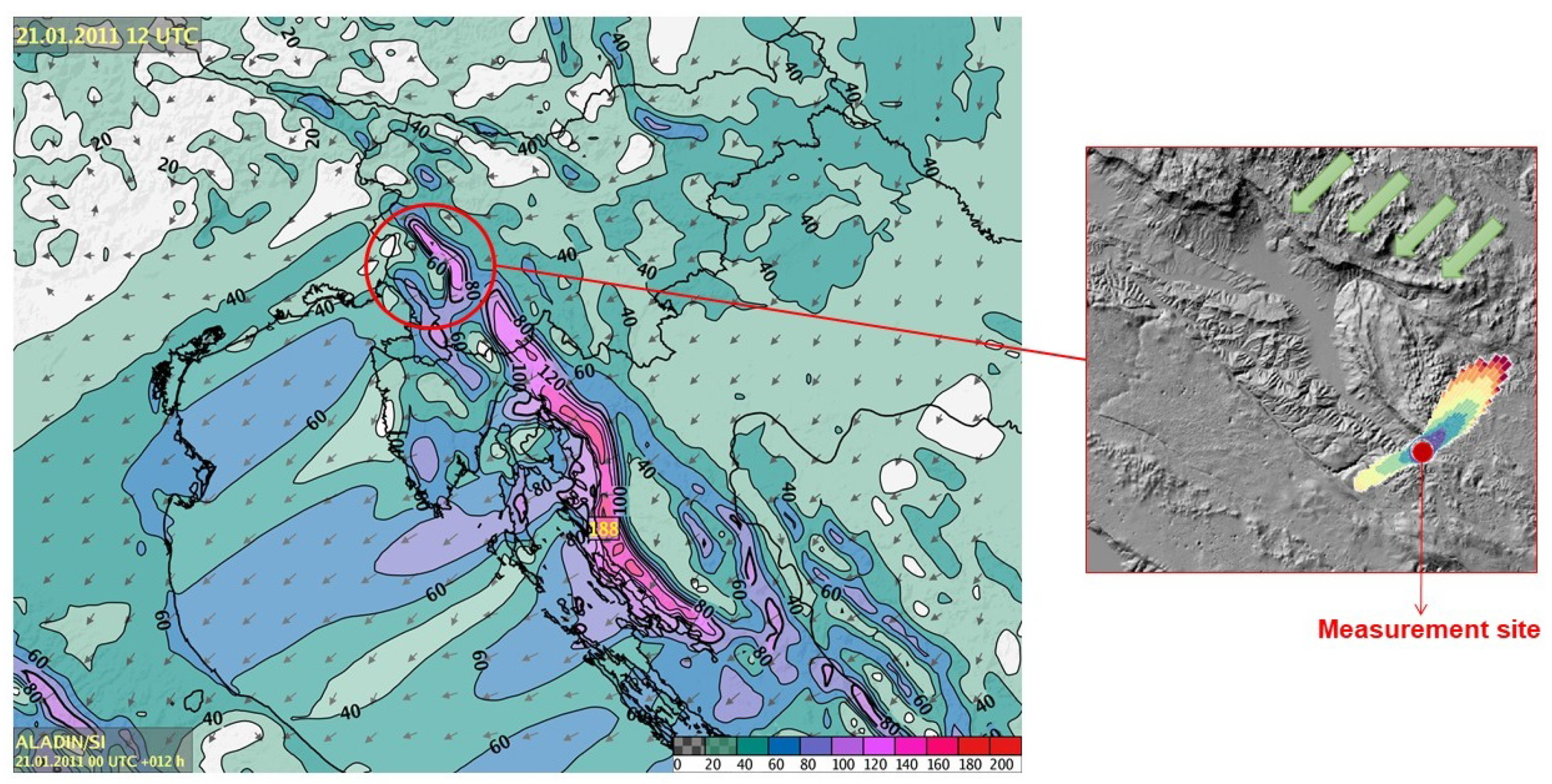

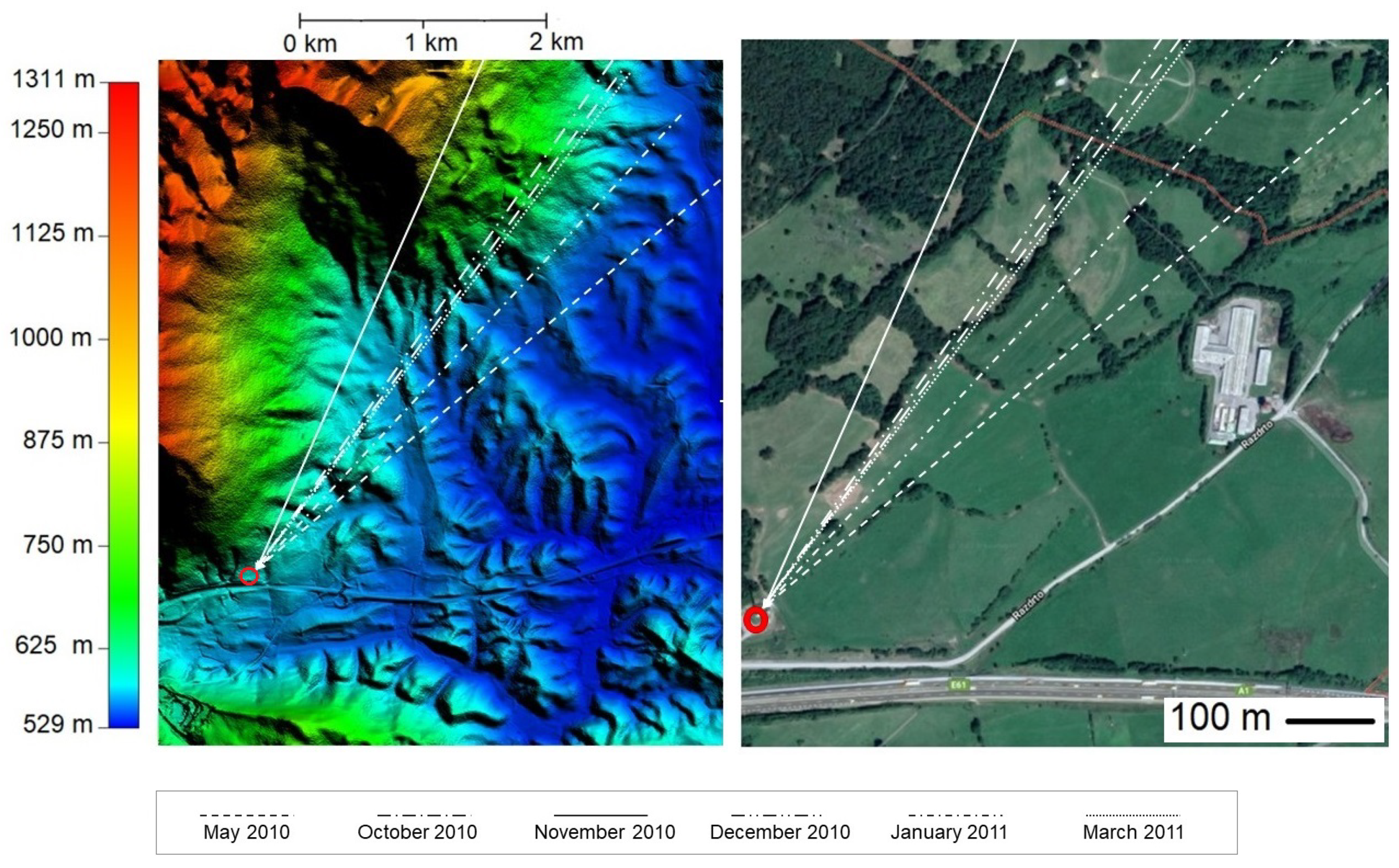
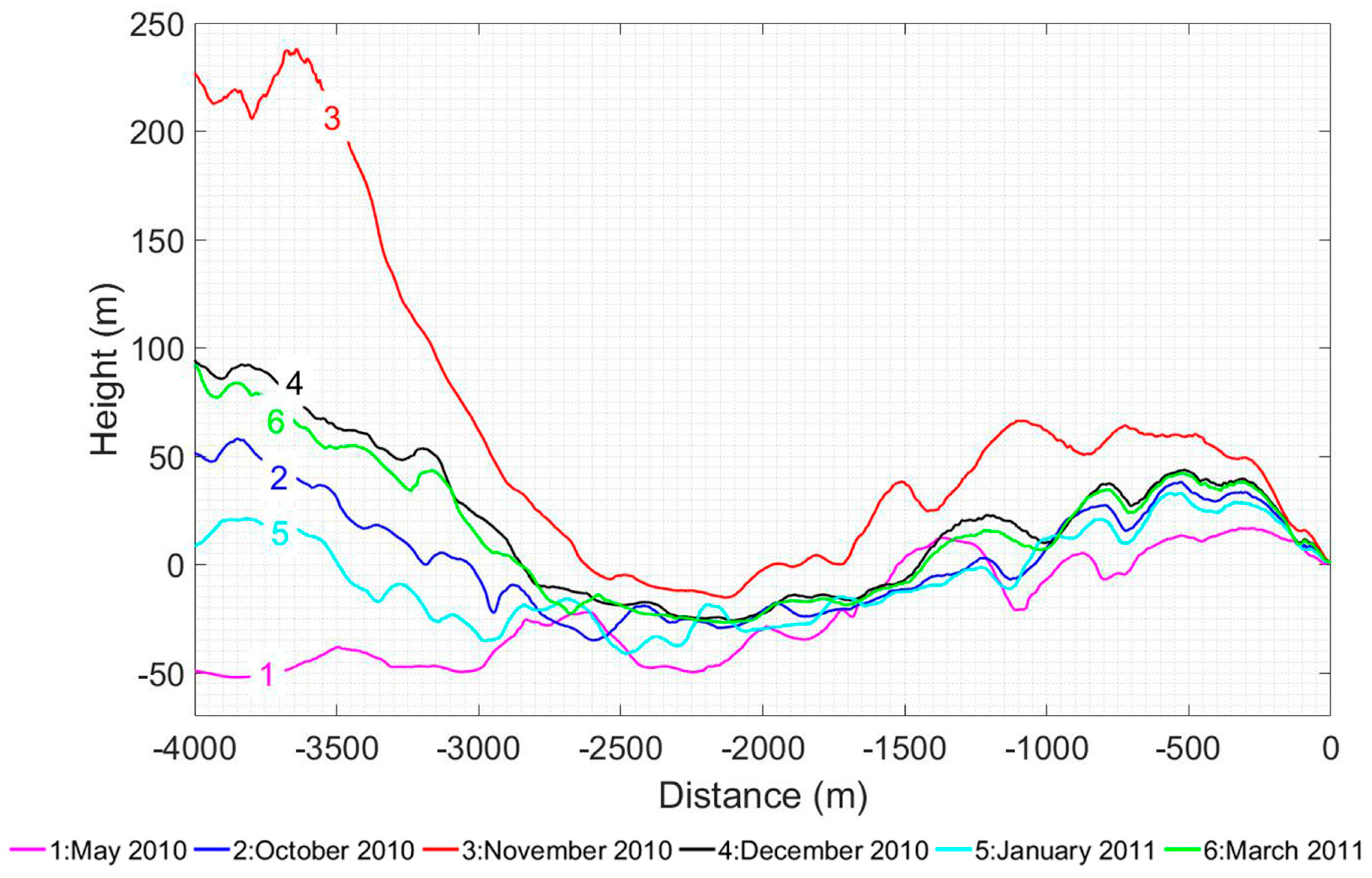
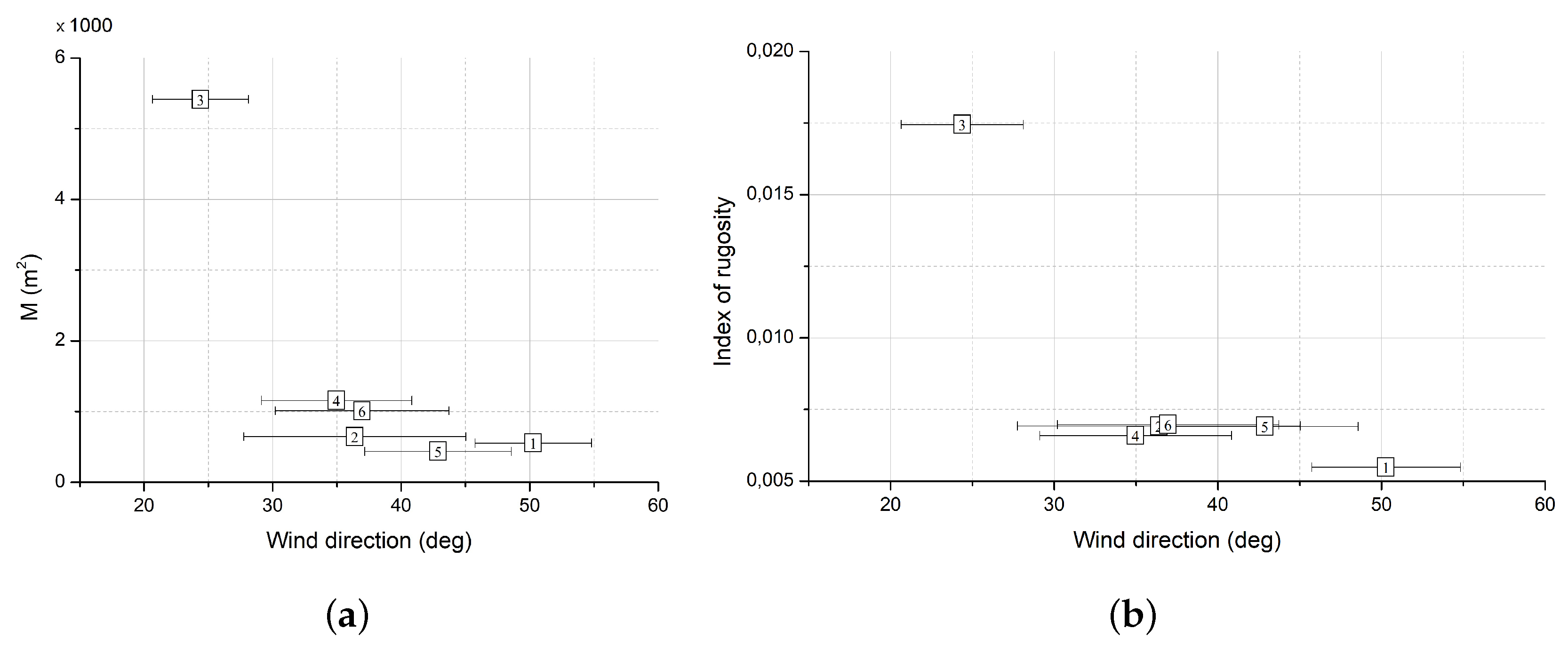

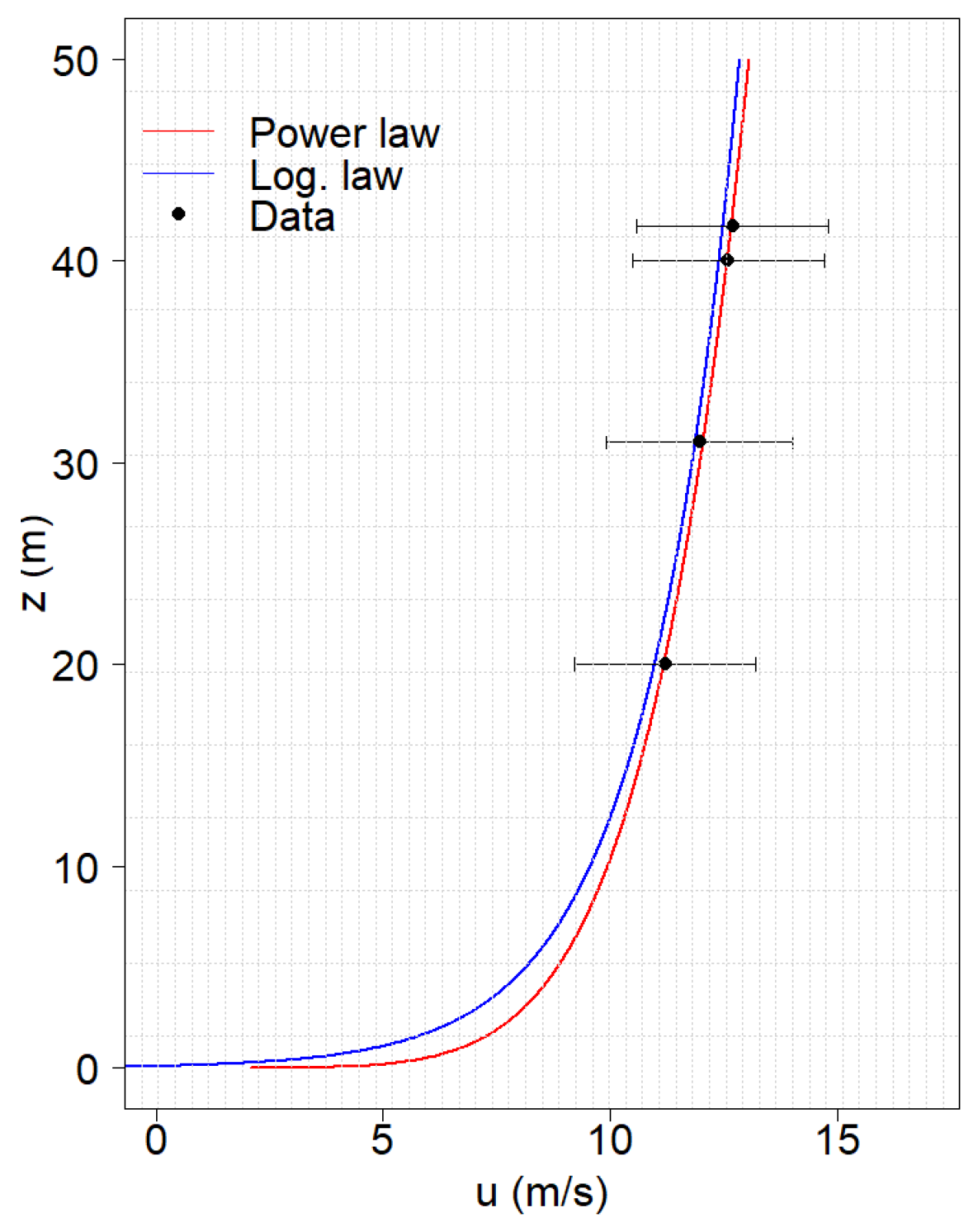
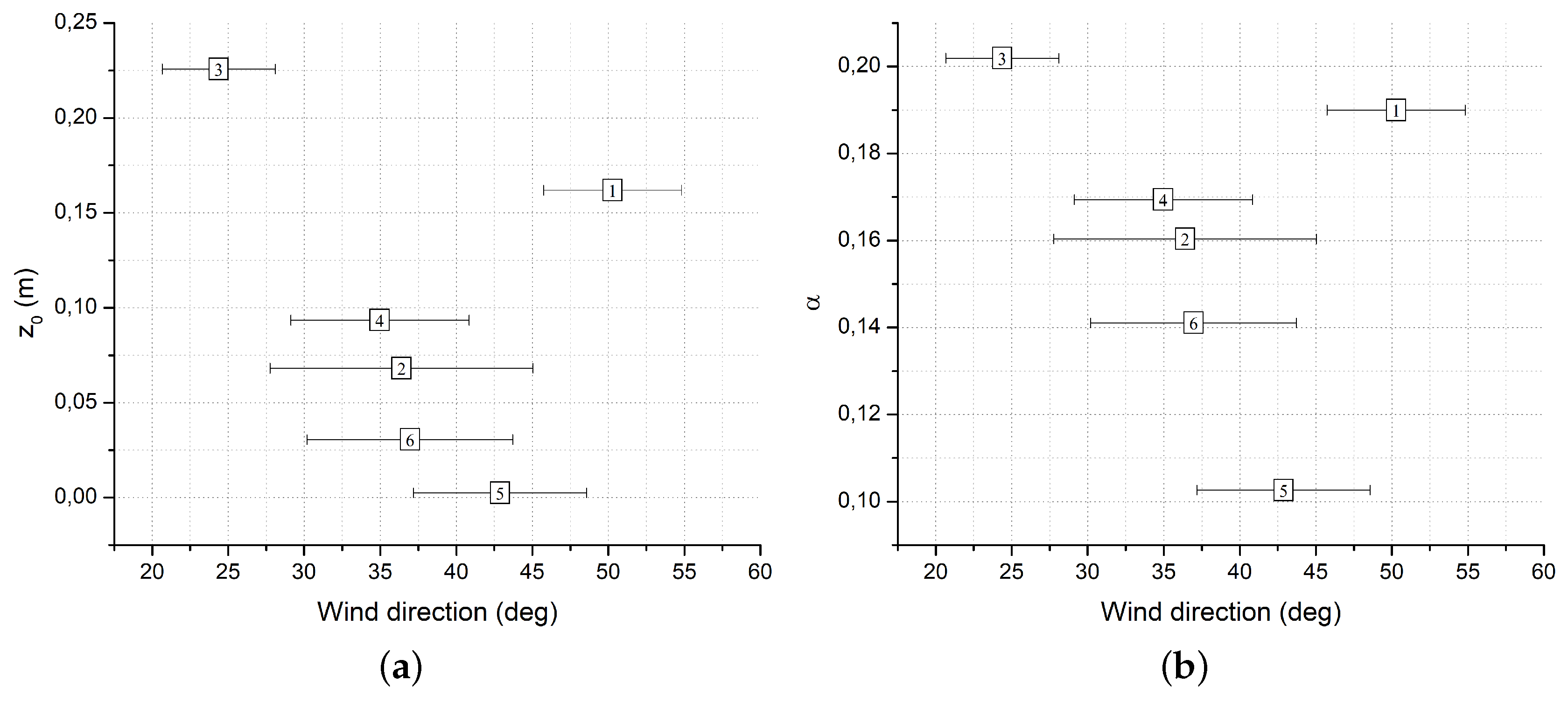
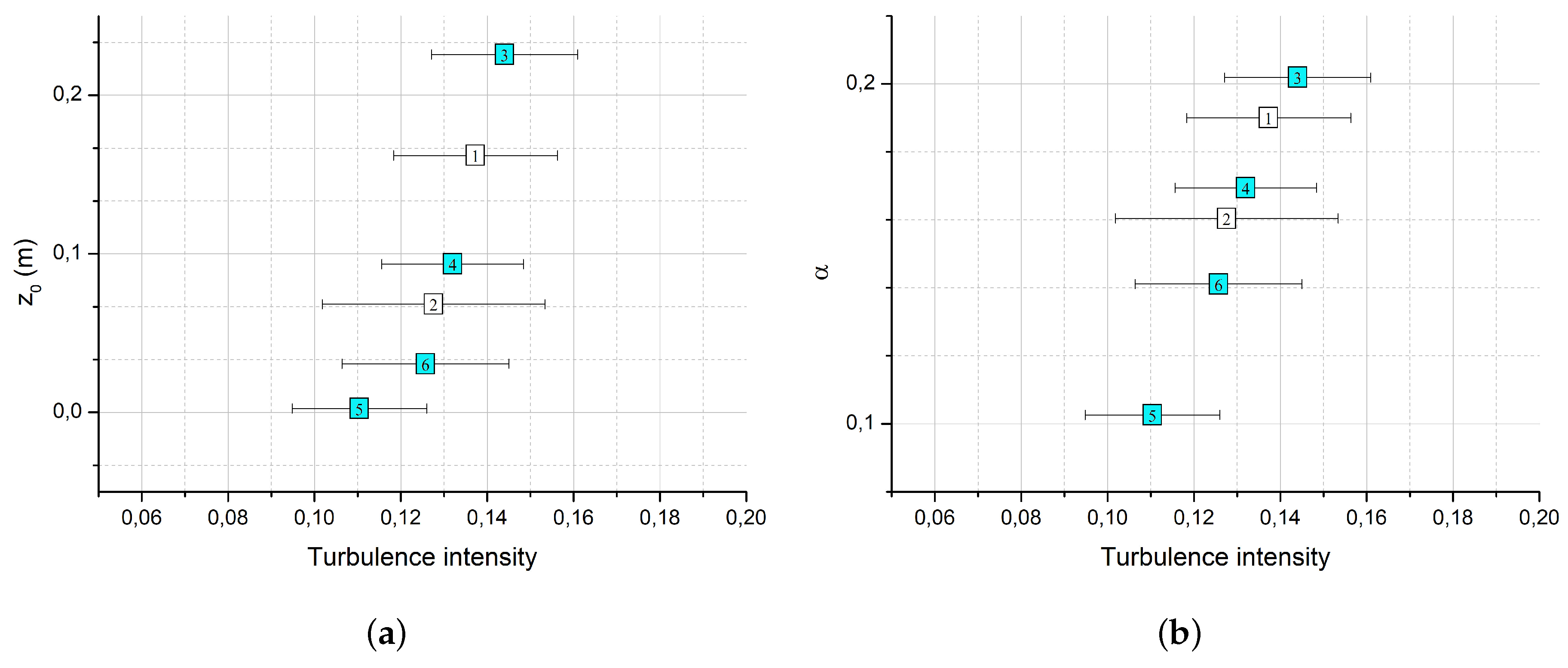
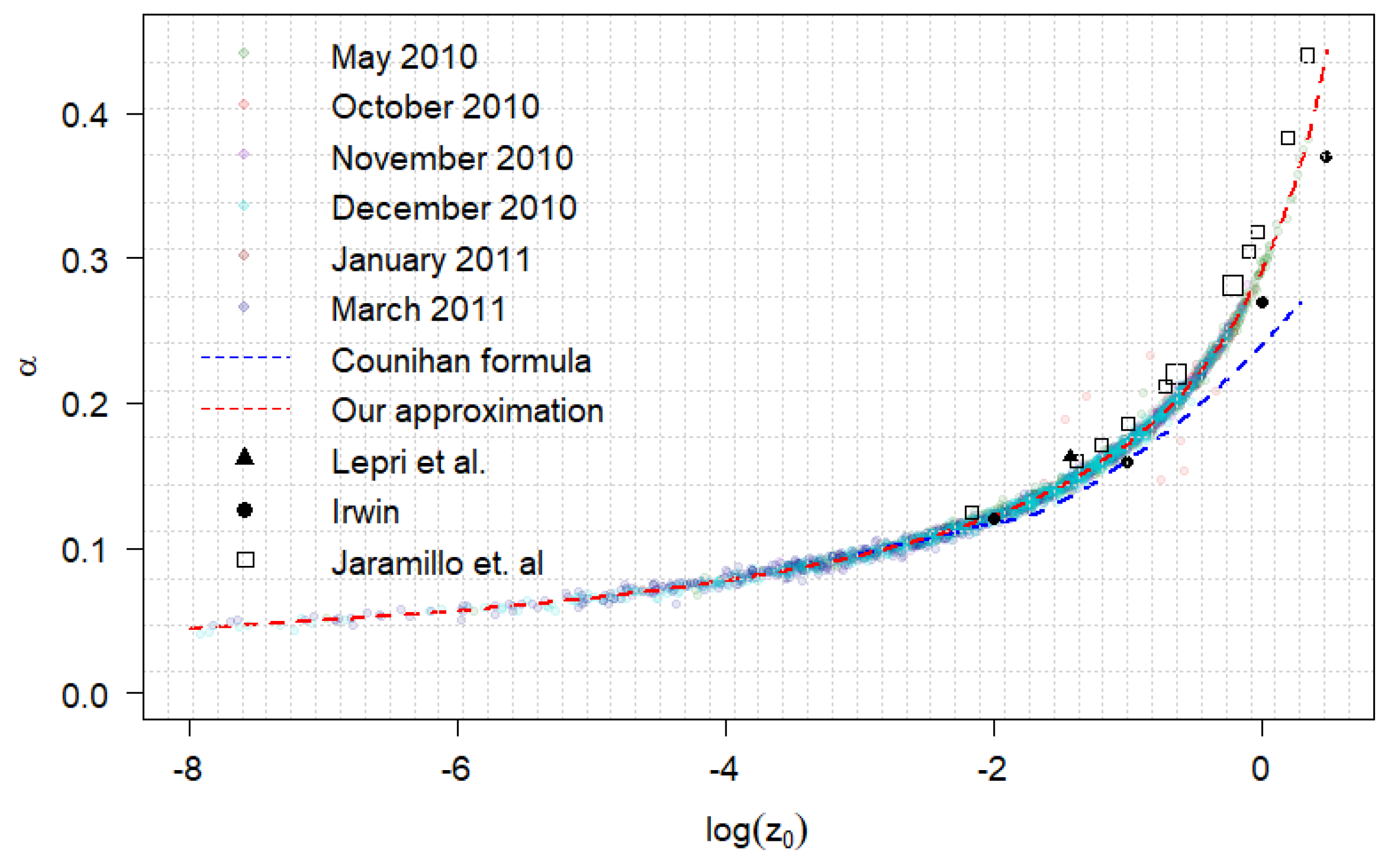
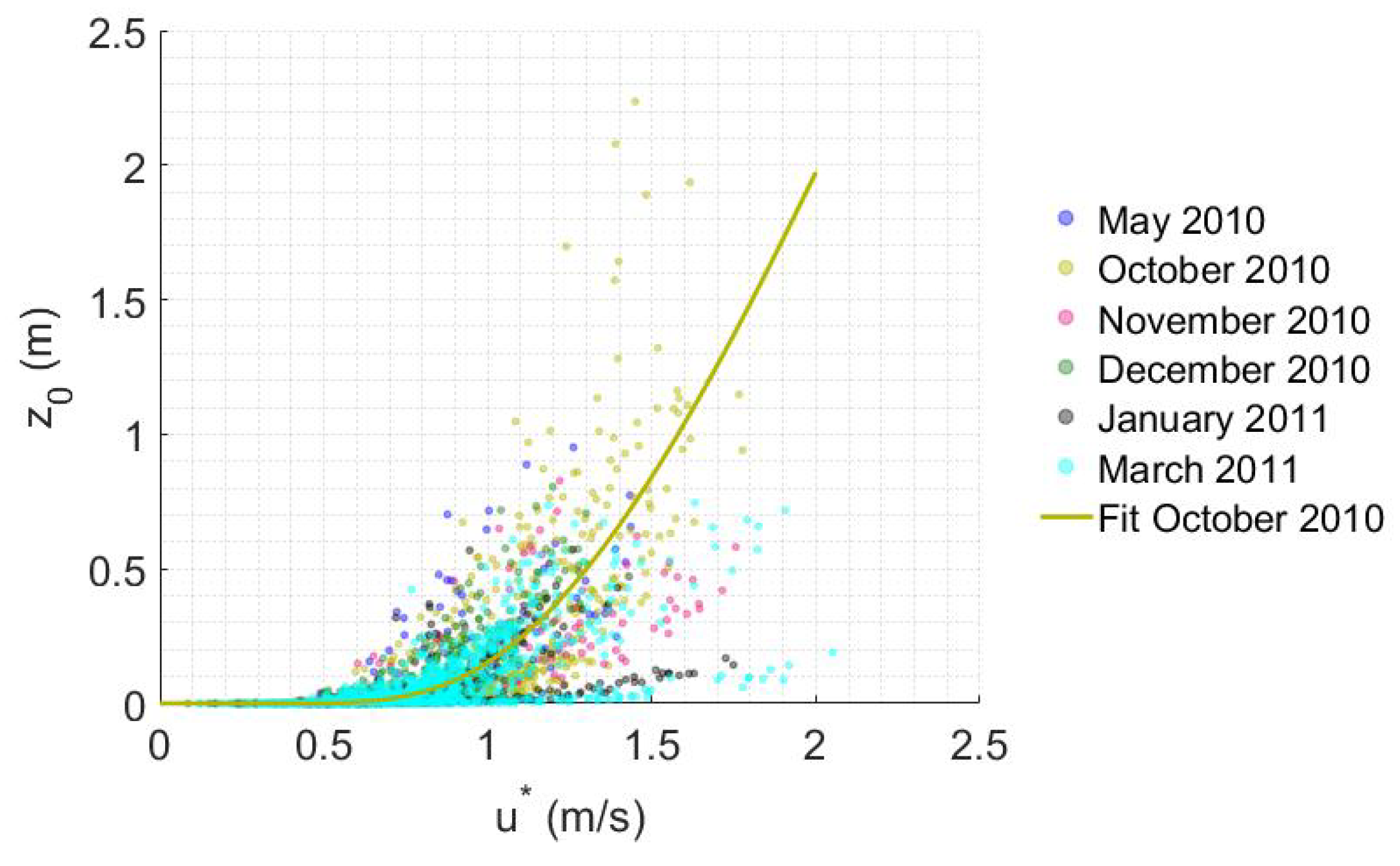
| Bora Event | May 2010 | October 2010 | November 2010 |
| Date | 15 May 2010 | 25 October 2010–29 October 2010 | 28 November 2010–29 November 2010 |
| Duration (h) | 15.00 | 87.67 | 16.34 |
| Wind direction (°) | 50.28 ± 4.54 | 36.39 ± 8.64 | 24.38 ± 3.73 |
| Wind speed (m/s) | 11.14 ± 2.12 | 13.03 ±2.42 | 12.21 ± 2.56 |
| Min. wind speed (m/s) | 7.21 | 7.51 | 7.23 |
| Max. wind speed (m/s) | 15.18 | 18.62 | 16.88 |
| Bora Event | December 2010 | January 2011 | March 2011 |
| Date | 25 December 2010–27 December 2010 | 20 January 2011–23 January 2011 | 27 February 2011–6 March 2011 |
| Duration (h) | 49.00 | 88.84 | 158.17 |
| Wind direction (°) | 34.97 ± 5.85 | 42.87±5.70 | 36.95 ± 6.76 |
| Wind speed (m/s) | 11.21 ± 1.99 | 14.41 ± 3.12 | 13.18 ± 3.77 |
| Min. wind speed (m/s) | 7.19 | 7.31 | 7.22 |
| Max. wind speed (m/s) | 15.79 | 21.10 | 25.25 |
| May 2010 | October 2010 | November 2010 | December 2010 | January 2011 | March 2011 | |
| Median | 0.189 | 0.160 | 0.202 | 0.169 | 0.103 | 0.141 |
| Arithmetic mean | 0.185 | 0.173 | 0.200 | 0.166 | 0.113 | 0.143 |
| Standard deviation | 0.049 | 0.061 | 0.033 | 0.047 | 0.041 | 0.048 |
| 0.997 | 0.997 | 0.997 | 0.997 | 0.994 | 0.995 | |
| (m) | May 2010 | October 2010 | November 2010 | December 2010 | January 2011 | March 2011 |
| Median | 0.162 | 0.068 | 0.226 | 0.093 | 0.002 | 0.031 |
| Arithmetic mean | 0.224 | 0.221 | 0.260 | 0.146 | 0.034 | 0.087 |
| Standard deviation | 0.226 | 0.337 | 0.177 | 0.160 | 0.081 | 0.130 |
| 0.989 | 0.998 | 0.989 | 0.987 | 0.982 | 0.985 | |
| (m/s) | May 2010 | October 2010 | November 2010 | December 2010 | January 2011 | March 2011 |
| Median | 0.879 | 0.945 | 1.109 | 0.839 | 0.648 | 0.804 |
| Arithmetic mean | 0.911 | 0.739 | 1.114 | 0.823 | 0.704 | 0.819 |
| Standard deviation | 0.265 | 0.283 | 0.305 | 0.232 | 0.283 | 0.303 |
| 0.989 | 0.998 | 0.989 | 0.987 | 0.982 | 0.985 |
© 2019 by the authors. Licensee MDPI, Basel, Switzerland. This article is an open access article distributed under the terms and conditions of the Creative Commons Attribution (CC BY) license (http://creativecommons.org/licenses/by/4.0/).
Share and Cite
Bervida, M.; Stanič, S.; Bergant, K.; Strajnar, B. Near-Ground Profile of Bora Wind Speed at Razdrto, Slovenia. Atmosphere 2019, 10, 601. https://doi.org/10.3390/atmos10100601
Bervida M, Stanič S, Bergant K, Strajnar B. Near-Ground Profile of Bora Wind Speed at Razdrto, Slovenia. Atmosphere. 2019; 10(10):601. https://doi.org/10.3390/atmos10100601
Chicago/Turabian StyleBervida, Marija, Samo Stanič, Klemen Bergant, and Benedikt Strajnar. 2019. "Near-Ground Profile of Bora Wind Speed at Razdrto, Slovenia" Atmosphere 10, no. 10: 601. https://doi.org/10.3390/atmos10100601
APA StyleBervida, M., Stanič, S., Bergant, K., & Strajnar, B. (2019). Near-Ground Profile of Bora Wind Speed at Razdrto, Slovenia. Atmosphere, 10(10), 601. https://doi.org/10.3390/atmos10100601





